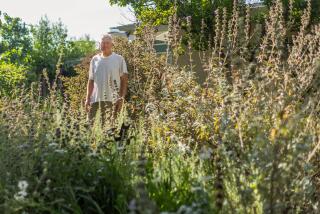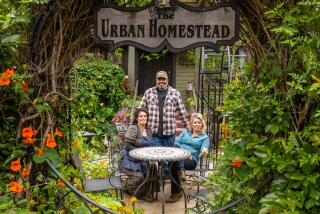Hoe
My grandfather loved the idea of farming. Tilling, irrigating, harvesting, pruning--he came to each one as a romantic. But he wasn’t a farmer, at least not the kind who could feed three children and cover his losses at the pinochle table. That poets made poor farmers should have been clear to him early on. Still, he kept growing crops in the 1930s, ‘40s and ‘50s. Vine hoppers devoured one raisin harvest. Mildew ate another. If the weather was good and the pests light, his own sloth would do him in. Relatives had a one-word explanation for his failure: politics. He was too busy reading New Masses, the Marxist monthly, when he should have been walking the rows.
Every family lugs around a story of lost gold. That last farm along the San Joaquin River became ours. A patient man would have found a way to keep it, Grandma said. A patient man would have been around to see it developed into big fancy houses. By the time I was growing up, the only vineyard in the family was the one in a painting that hung from our adobe fireplace. My grandparents had moved into a house on Garland Street in the heart of Fresno, where their distance from the farm was made plain everyday. Right outside the front door, a huge irrigation canal sliced through the neighborhood, shooting Sierra snowmelt past suburbia to faraway farms.
I was 9 or 10 when Grandpa took aim at a giant pine tree in their tiny backyard next to the swimming pool. He cut it down and for months hacked and picked at its trunk. Into its hollowed core he poured bags of salt, but the roots refused to die. They seemed to reach everywhere, and he went at them with shovel and ax. At some point, he decided that the tree’s roots weren’t enemies but friends. Given enough time, he reasoned, they would decay into mulch. And mulch was just what he needed to turn suburban dirt into country loam.
By spring, he had finished clearing the 30-by-30 plot and carved out a dozen rows. We drove to Kmart and he bought six-packs of every vegetable I could name. The way he placed them into the ground--measuring 22 inches between each plant, pressing gently and then firmly with both thumbs--it took all afternoon. Then he put the hose on one end and let it trickle for hours. The old pine tree roots, it turned out, made for a marvelous system of sub-irrigation. All by themselves, they channeled the water row to row until the earth turned black on the other end. It was drip irrigation before its time.
Grandpa believed any hardening of the earth choked the young plants. “They’re like people,” he said. “Plants need to breathe to grow and produce.” So a few days after each soaking, as the ground began to crack, he’d grab his cherished long-handled hoe and go to work. He’d spend 20 minutes bent over each row, hoeing and hoeing until every last dirt clod was broken up, and the earth was fine and fluffy. He was so fastidious that when he finished the last row, he returned to the first row to hoe away any prints left behind by his shoes. Only then did he light his pipe and stand there admiring his labor: sturdy young tomatoes, eggplants, peppers, squash, cucumbers and melons rising from fresh beds across what was once Bermuda grass.
My grandfather, I discovered, was not alone. A legion of failed Armenian, Italian and Japanese farmers were making last stands in their backyards. He’d take me to the houses of Armenian friends, houses filled with doilies and mothballs, and as we walked past the front door, old country men would bend down and yank on my ear. For the unbearable pain of getting it nearly pulled off my head, they’d reach into their pockets and hand me a nickel or dime or quarter, depending on whether they came from Van or Bitlis or Moosh.
They’d ask me, “Who do you love better, your mother or your father,” a riddle I took to mean that life itself was made up of impossible choices. Then we’d have to go in their backyards and marvel at the size of their Ace tomatoes or stare in wonder at the deep purple of their Black Beauty eggplants. After a cup of Turkish coffee, Grandpa would say goodbye and we’d climb back in the car. “Can you believe the state of that garden?” he’d ask me. “He thinks water can make up for every sin. What the eesh (jackass) needs is a good hoe.”
I knew my grandfather was a good backyard farmer, but it wasn’t until he added okra to the summer mix that he showed a truly special touch. The plants came up strong and never stopped growing, rising past me and then the roofline and then straight to the sun. He had to climb a ladder to harvest the fuzzy green pods filled with tiny egg-like seeds that he devoured like caviar whenever Grandma made her bahmya stew.
As his eyesight began to dim, he counted on me to find the Armenian cucumbers, the gootahs, hiding beneath the vines. Having a keen eye was important because a day of irrigation followed by a night of warm air was enough to double a cucumber’s size. Left to grow, the gootah became a rank melon. Picked at the right time, it had the nuttiest and sweetest flavor of any cucumber around, making poor cousins out of the English and Japanese.
Grandpa died in 1989, and the ground went back to dirt and then Bermuda. A few years later, after placing Grandma in a nursing home, we all gathered at the Garland Street house to divide up their small estate. There were filigreed coffee holders from Armenia and antique glassware from San Francisco and old issues of Soviet Life. I made a beeline to my aunt’s painting of Grandpa sitting in his summer garden and gave a best case why it should go to me. If there was a protest or two, I didn’t hear it.
But that’s not all I really coveted. Before I left, I sneaked into the backyard and reached into the tool shed and grabbed Grandpa’s hoe.
I had become a decent backyard farmer myself. Everything I knew he had taught me in the years after my father was murdered in 1972. The one lesson I found hardest to master was the lesson of tilling. No matter what hoe I used, I could never get the earth to look the way he made it look. And then he was gone, and I decided to give his hoe a try. There was a slight crack in the handle, and I babied it at first. As it turned out, it was plenty sturdy. Like one of those Big Bertha golf clubs that add 80 yards to your tee shot, it had a perfect head, just the right weight, and seemed to do all the work for you.
Row after row, I hoed and hoed, and then I gave the ground a good soaking. And here is what I discovered, what my grandfather never told me, what I am reminded of each new summer: It wasn’t those pine tree roots after all. The secret of sub-irrigation was all in the soil and the hoe. The soil, if properly worked, was its own sponge. The soil, if allowed to breathe, soaked in air and water. You just put the hose on one end and let it trickle.






